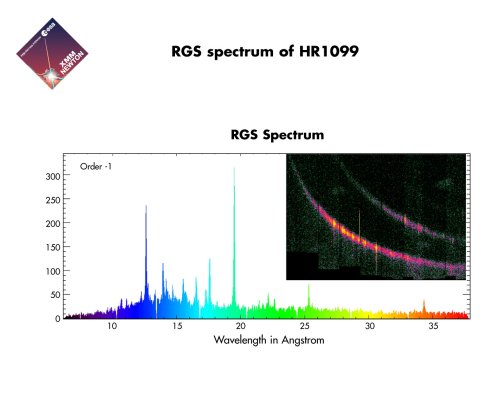XMM-Newton RGS First Light - HR1099 1

Image and text courtesy of ESA
RGS spectrum of HR1099
RGS spectrum of the star known as HR1099. The spectrum illustrates the way the RGS works; it decomposes X-ray light into its components, like a prism does with visible light. The inserted image shows what is referred to as a banana image. The horizontal axis shows the detected X-ray photons (X-ray light particles) plotted as a function of the position on the detector (strip of nine CCDs) and as a function of the energy of the photons, as determined by the CCDs, along the vertical axis. Get the high resolution version.
Discovering the elements
The final two examples of the initial data collected by XMM-Newton take the form of spectra. They are provided by one of the two Reflection Grating Spectrometers (RGS). Just as in optical spectroscopy, different elements absorb and emit light at specific and unique points of the radiation spectrum. The RGS spread these out in the form of two "bananas", the two so-called "spectral orders" of the instrument. Emission lines appear as distinct features in the rainbow of X-ray colours, acting as signatures that reveal a great deal of information to astronomers.
The RGS spectra of HR 1099 are examples. The graphs display peaks or lines that correspond to the various elements present in the source. One can distinguish for instance the presence of different types of iron, oxygen carbon and neon. From the analysis of this data one can deduce the temperatures, densities, abundances and velocities of the different materials.
"Firstly, the nice separation of the two spectral order bands shows the resolution of the RGS CCDs is well up to expectations" comments Bert Brinkman, RGS Principal Investigator. "For the spectrometers as a whole, the resolution which is of prime importance, is exactly or marginally better than what we expected after the ground calibrations. The instruments promise a lot for the future."
If you have any questions concerning XMM-Newton send e-mail to xmmhelp@lists.nasa.gov



